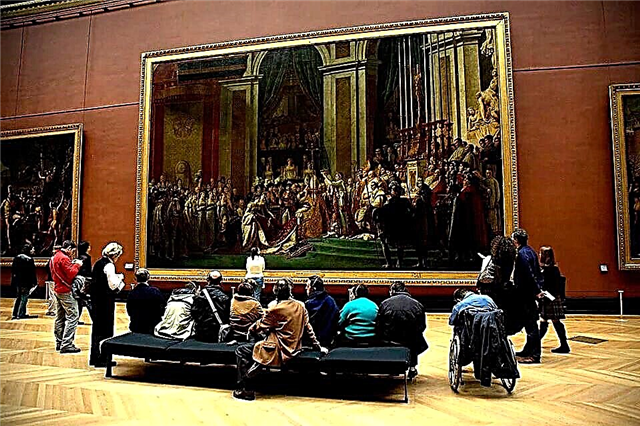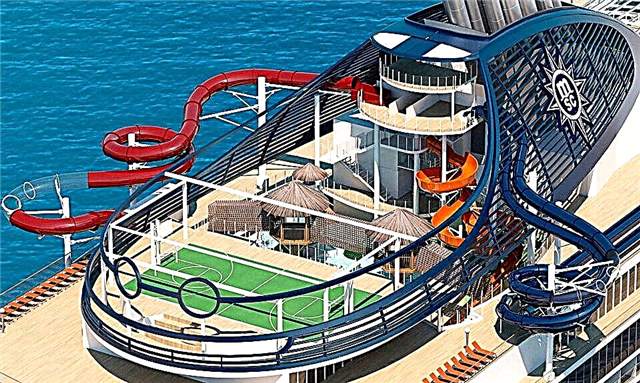On the right bank of the Seine in the center of Paris rises a magnificent Baroque palace complex, which contains a grandiose collection of masterpieces of art from ancient and Western European civilization. This is the world famous Louvre Museum.
History of creation and interesting facts

Before becoming the largest in the world, the palace experienced many tragedies, intrigues, conspiracies and uprisings. At various times, it served as a medieval fortress, a royal residence and a national assembly. The formation of the complex is inextricably linked with the history of France.
At the end of the 12th century, on the initiative of King Philip II Augustus, a fortress was erected to protect Paris from the invasion of the Normans and the British. The structure was a cylindrical tower surrounded by solid high walls with massive gates. The medieval feudal castle was named the Louvre, which translated from Frankish means "to be on guard." It housed the treasury, valuable archives and a prison.

Over time, Paris grew. The emergence of new buildings around the fortress contributed to a significant transformation of the Louvre. Once in the center of the city, the castle lost its defensive significance. In the 14th century, the monarch Charles V transforms the gloomy citadel into a royal residence. New towers were built, a luxurious garden was laid out and pompous royal apartments were equipped. Severe winters, famine, plague epidemics, peasant uprisings and wars with England left the residence of the French kings in a miserable state for many years.
Throughout the 15th century, the Louvre was in disrepair. The monarchs lived far from the capital. Fundamental changes took place in the 16th century, when Francis I ascended the throne of France and returned the royal residence to Paris. The castle is completely rebuilt in the Renaissance style. Instead of medieval towers and walls, a long construction of the palace begins with new wings, an inner courtyard, an arcade gallery, expanded state rooms, a covered passage and decorated facades.

The reconstruction of the Louvre was put on hold for some time, when in 1682 King Louis XIV decided to move his residence to Versailles (a suburb of Paris). Although the building remained unfinished, the royal apartments housed French painters, sculptors, scientists and itinerant merchants. Since 1699, art exhibitions for the privileged nobility began to be held in the palace.
After the French Revolution, the Louvre became a cultural heritage of the people. The first art museum in France was opened there. From now on, Parisians are begging to admire the masterpieces of the royal collection. The complex has become available for public viewing. During the reign of Napoleon I, the Louvre was replenished with new works of art confiscated from the nobility, emigrants and clergy. The emperor's military victories enriched the complex with unique exhibits taken out by French troops from the conquered countries.
Royal Palace

For several centuries, the royal palace Louvre, which is a symbol of the French state, has been rebuilt and expanded several times. Each monarch made his own adjustments to the appearance of the architectural complex. It acquired its modern appearance in 1871. The perimeter is over 1.5 kilometers.
The architectural ensemble consists of three main buildings. One wing stretches along the Seine embankment, the other runs parallel to the Rue de Rivoli. In the center is a square building with a courtyard. The facades are decorated with luxurious arcades, colonnades with ornate capitals, pilasters, relief images, balustrades, semicircular and triangular pediments and numerous sculptural statues.
Collection creation
King Francis I laid the foundation for the Louvre's first art collection. Having visited Italy, the monarch was fascinated by the splendor of the achievements of the Renaissance culture. He brought to France many paintings and sculptures that carry the idea of man's eternal striving for perfection. In 1517, Francis I invited the famous artist Leonardo Da Vinci to France.
The king gave the master a warm welcome and appointed him chief court painter. After the death of the genius Leonardo, 19 of his paintings remained in the Louvre, among which the most famous canvas was the portrait of Mona Lisa. The royal collection was constantly replenished with masterpieces of art celebrating the power of the monarchy. Especially zealous connoisseurs of works of art were the great ministers of France from different eras: Richelieu, Mazarin and Colbert.
They, without stint, acquired canvases from all over the world. Since the 19th century, archaeologists actively working in Egypt and the Middle East have contributed to the formation of the Louvre collection. Unique ancient artifacts, manuscripts and ancient statues were brought.
Louvre today

The internal area of the museum is 60,000 square meters. More than 8 million tourists visit the landmark of the French capital every year. The collection of the museum is represented by 370,000 exhibits dispersed in the buildings of the palace complex. Today the Louvre is one of the largest museums in the world. The palace houses a rich collection of works of art from ancient times to the middle of the 19th century. The Louvre is a UNESCO World Heritage Site.
The abduction of the Mona Lisa
In 1911, one of the museum's old employees made his way into the art pavilion without hindrance and kidnapped Leonardo Da Vinci's La Gioconda. Only a day later, the disappearance of the canvas was discovered. For several years, the police could not find the portrait, which was all this time in the robber's modest apartment.
Because of the incident, an incredible scandal erupted, after which the painting by the Italian master became the most famous and mysterious masterpiece in the history of art. It became apparent that the museum was experiencing difficulties in ensuring the security of the collection. The Louvre needed internal reforms in this area. Instead of the position of director of the museum, a commissioner was appointed who increased the number of guards and introduced strict rules for visiting the Louvre. All exhibition halls were refurbished, an elevator was installed and electricity was supplied.
Why did you need a pyramid

The glass pyramid of the Louvre serves as the main entrance. The structure was erected in 1989 by the American architect Bei Yuming, according to a major restoration project of the complex. The structure contrasts with the magnificent buildings and gives the architectural ensemble a certain modern charm. The original task of creating a pyramid with an underground entrance to the museum was to unload the historical entrances, which with great difficulty coped with the endless streams of visitors.
Description

It consists of three buildings. They are connected by an underground passage. These are the wings of Richelieu, Denon and Sully. In the spacious rooms of the Louvre, you can see numerous objects of art characterizing different historical eras - paintings, sculptures, royal furniture, porcelain, tapestries, household items, jewelry, antique statues and artifacts.
The luxurious interiors of the museum are breathtaking. The halls are decorated with ceiling arches with graceful columns, frescoes and bas-reliefs. The premises in which the antique exhibits of Ancient Greece, Egypt, and the Middle East are exhibited are located on the first floors. Fine and applied arts occupy the second and third floors.
Exposition

The Louvre pavilions present collections of the most valuable exhibits that embody the cultural heritage of different eras and peoples. The exposition is divided into thematic zones. These are Egyptian and Middle Eastern antiques, Greek and Roman sculptures, artifacts of French kings, paintings by great artists from all over the world. Noteworthy is the large hall with an arched ceiling, where Greek sculptures stand among slender columns. Antique sculptures express the beauty of the human body.

An important place in the Louvre's exposition is occupied by the armless marble statue of Venus de Milo. This is the only original in the world of the ancient Greek goddess of love and beauty with a fully preserved head. Crowds of tourists flock to see the museum's priceless masterpiece.

The Louvre's most popular exhibition space is the art gallery. Its walls are decorated with paintings by Italian painters - Raphael Santi, Domenico Ghirlandaio, Caravaggio, Leonardo Da Vinci and many others. The museum contains over 6,000 paintings. The collection of fine art is amazing. Visitors can see works by artists from the Renaissance, Classicism, Impressionism and Modernism.

The Louvre's vibrant exhibition hall is called the Apollo Gallery. The ceiling is decorated with magnificent frescoes depicting scenes from Greek mythology. The paintings are enclosed in gilded frames decorated with ornate stucco moldings. This room also houses a collection of jewelry from French kings.
The most famous paintings

The pearl of the Louvre is undoubtedly the work of Leonardo Da Vinci "Mona Lisa", written more than 500 years ago. Covered in bulletproof glass, this small iconic painting is a portrait of a woman. Her serene and mysterious smile has fascinated visitors to the Louvre for centuries. Paolo Veronese's The Marriage at Cana of Galilee is the Louvre's greatest piece of art. Its height is 7 meters and its width is 11 meters. The painting depicts a biblical story. Jesus Christ, invited to the wedding, turns water into wine.
Skip the line
It is recommended to visit early in the morning. At this time, there are few guests of the Louvre, which allows you to pay more attention to works of art without the hustle and bustle of excursion groups. Tickets purchased in advance will save you from standing in long lines lined up at the museum's ticket office. It is possible to order them online by going to the Louvre's official website (www.louvre.fr).
Opening hours and ticket prices
The Louvre is open every day, except Tuesday and the following holidays: New Years, Christmas, International Workers Day. It works from 9:00 to 18:00 (Monday, Thursday, Saturday and Sunday) and until 21:45 (Wednesday, Friday). The cost of a full-day ticket is 15 euros.
Where is the Louvre and how to get there
Located in the center of Paris at Palais Royal, Musée du Louvre. You can get there by regular buses No. 21,27,39,68,72,95, as well as by metro to the station of the same name. It is also possible to arrive at the Louvre on a pleasure boat. The pier is within walking distance of the museum.











